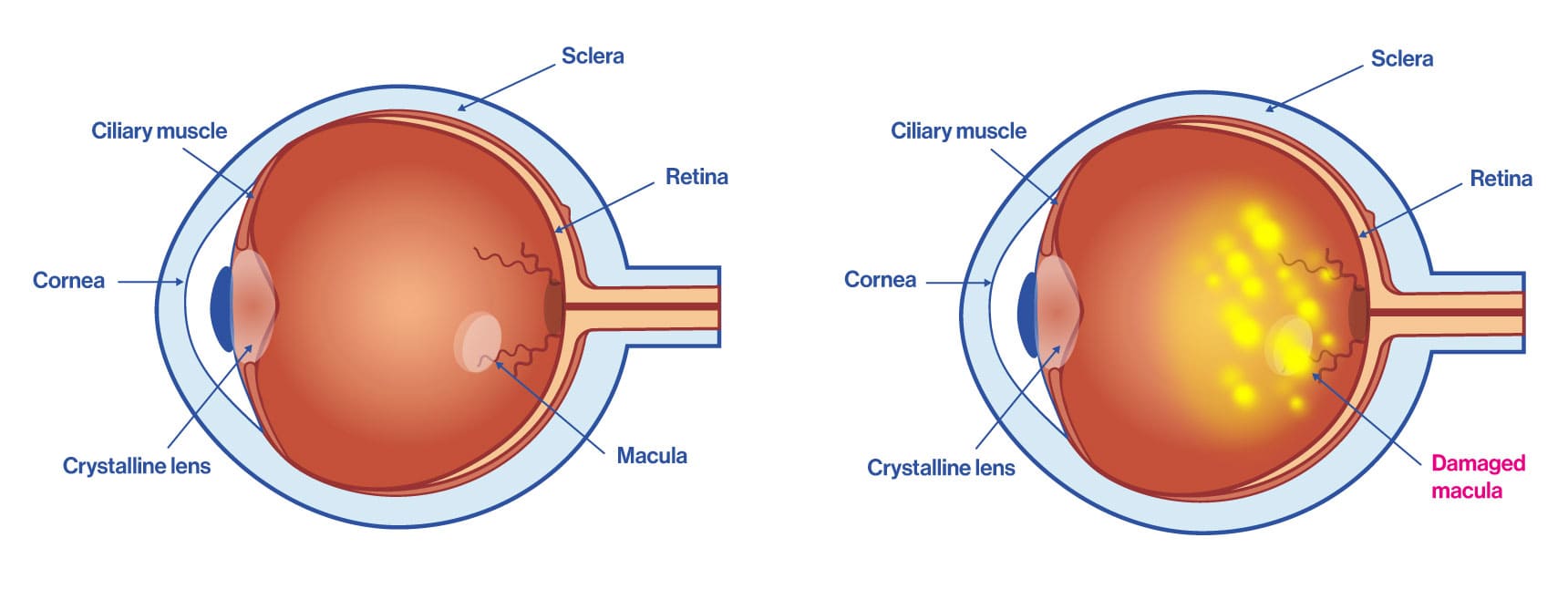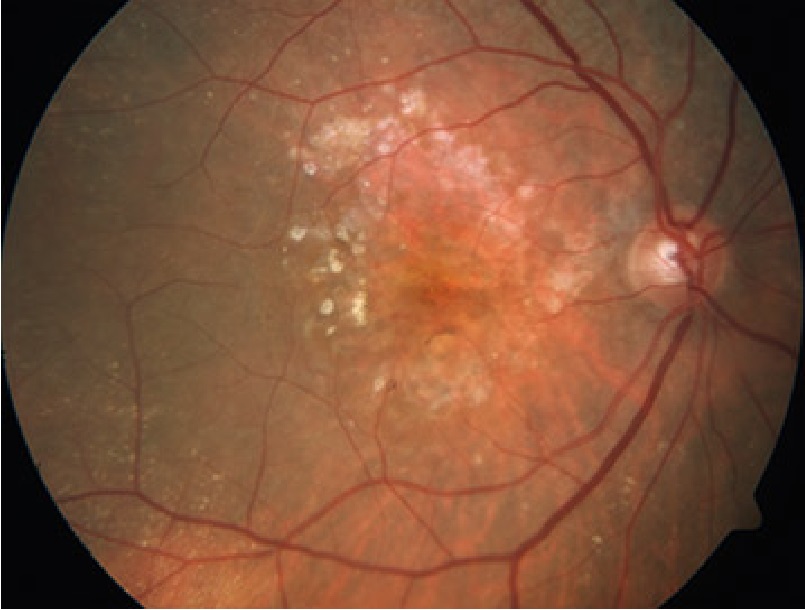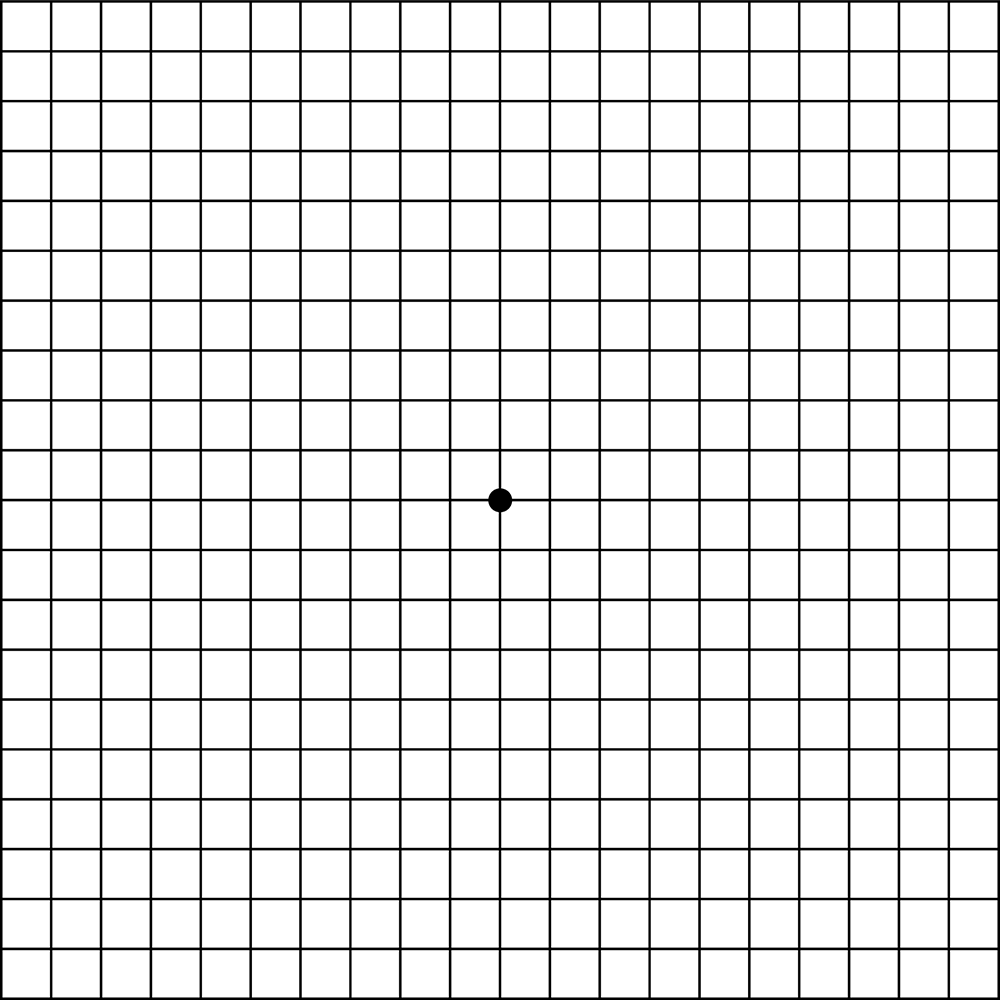Retina / Age-related Macular Degeneration (AMD)
What is macular degeneration (AMD)
AMD is a hereditary neurodegenerative disorder that affects the largest part of the retina that is responsible for vision, known as the macula. It does not hurt, but it does cause the cells in the macula to die.
It is the most common cause of blindness for people over 50 in Spain, with a frequency that increases exponentially from the age of 70 onwards, as does the severity and the chance of it affecting both eyes, particularly from the age of 85. As such, many elderly people develop macular degeneration as a natural part of the aging process that affects the entire body, including the eyes.
This disorder causes loss of acuity in central vision, which is important for viewing objects clearly and performing activities like reading, watching television and driving, which require detailed vision.
In patients with one eye affected by AMD, the risk of the good eye also being affected is up to 100% within 5 years.
Types of macular degeneration (AMD)
Symptoms of dry or atrophic AMD
This is the most common form of advanced AMD and is characterised by slow but constant progression over several years, until eventually the sufferer loses central vision entirely. It is important to assess the type of atrophy and associated drusen to identify the disorder’s risk of progression. This type is caused by ageing and thinning of the macula tissue.
If the patient suffers from dry macular degeneration, their loss of vision will be gradual. As such, it is important to carry out daily check-ups and also to perform the Amsler grid test.
If there is no suitable treatment available, the patient may benefit from a diet of vitamins and food supplements.
Early AMD
Mid-stage AMD
Advanced AMD
Symptoms of wet AMD
This is the most serious form of AMD and is characterised by sudden visual disturbances caused by haemorrhaging and a build-up of liquid in the macula. This process causes scarring and sometimes severe loss of central vision. New blood vessel formations begin to develop under the macula, forming what is known as a neovascular membrane.
Hidden AMD
This usually causes less severe vision loss. It occurs as a result of new blood vessels developing under the retina and loss of fluid, although in a less obvious way.
Classic AMD
Causes more severe vision loss. The development of blood vessels and scarring under the retina is more significant in terms of size.
Causes of Macular Degeneration (AMD)
The primary risk factor is age, as the probability of developing AMD increases progressively from the age of 50. Other factors are:
→ Obesity: according to some studies, obese people are at a greater risk of progressing from the early and mid stages to the advanced stage of macular degeneration at a faster rate.
→ Smoking: this increases risk by altering choroid circulation. Smokers also respond less effectively to treatment.
→ Sex: women are usually more susceptible to developing macular degeneration than men.
→ Race: white people are more likely to develop macular degeneration than African Americans.
→ Family history: those with direct relatives that suffer from macular degeneration have a higher risk of inheriting the disorder.
→ High blood pressure: there is a possible correlation between high blood pressure and macular degeneration.
→ Light-coloured eyes.
The most common cause of macular alteration is age-related macular degeneration, although it may also occur with any other disorder that affects the macula in both eyes, such as diabetic retinopathy or hereditary diseases that affect the macula, such as Stargardt disease.
When the cause is wet macular degeneration, depending on how far the disease has progressed, we should at least be able to restore detailed vision at least partially through anti-angiogenic injections.
The patient should notice that the black areas or distortions that they were seeing in their central vision are now clearer and less distorted. If the disease is very advanced, with atrophy or scarring to the macula, it will not be possible to improve it. In any case, it will not result in total blindness. This is why early diagnosis and treatment is so important.
Symptoms of Macular Degeneration (AMD)
The initial stages of AMD do not produce any symptoms, which is why it is important to examine the back of the eye on a regular basis from the age of 50, particularly if there is a family history of AMD.
The most common symptoms are:
→ Blurry central vision, with difficulty reading, watching television, paying with coins.
→ Straight lines appearing distorted (frames of windows and doors, the television, streetlights).
→ Difficulties recognising depth and height, objects appearing abnormal in shape and size, which makes it difficult to go down stairs and place objects.
→ Dark blotches in the central field of vision.

Symptoms of dry AMD
The most common symptom is blurry vision. As the cells in the macula deteriorate, there is a loss of detail in visual acuity, although it usually improves in brighter light.
If the loss of light-sensitive cells is more severe, a small spot may appear in the centre of the field of vision, which grows in size over time.
Symptoms of wet AMD
The most common symptom is that straight lines appear wavy. This happens when blood vessels leak fluid, which accumulates under the macula, causing visual distortion.
A small spot may also appear, causing loss of central vision.
Macular Degeneration Prognosis
Macular degeneration may lead to loss of central vision, causing the sufferer difficulties when it comes to reading, driving or recognising faces clearly at a distance.
However, people who suffer from this disorder, while they must be treated immediately, will be able to carry out other daily activities as their peripheral vision is not affected, so they have not lost their vision entirely.
→ Mild dry AMD: the loss of vision caused by the disease is not incapacitating.
→ Wet AMD: does lead to a significant loss of vision.
Diagnosing Macular Degeneration
The specialist ophthalmologist should carry out a full examination, performing a series of essential diagnostic tests, paying particular attention to the condition of the macula.
The appearance of the back of the eye examined by an AMD expert will in most cases give a strong indication of the risk of developing this disease.
The type of macular discolouration and the type of deposits (drusen) that appear with age as a result of macular ageing are important when recommending a monitoring pattern for an early diagnosis of AMD, so the earlier the diagnosis is made, the better the chances of stopping the disease in time.
Visual acuity test
Fluorescein angiography
Optical coherence tomography (OCT)
Amsler test
Treating Macular Degeneration (AMD)
Treating dry AMD
There is still no effective treatment for this type of macular degeneration, although we are carrying out clinical trials on various medications to slow down its progression, with promising results. It is recommended that patients take specific vitamin complexes, as some studies show that they slow down the disease’s progression.
Treating wet AMD
There is a treatment for this form of the disease. In fact, the correct administration of anti-angiogenic medication injected into the eye (intravitreal injections) can prevent blindness in over 95% of cases, and restore vision in a third of all cases.

DMAE dry form
With the wet or exudative form of AMD, treatments with intraocular injections can prevent loss of vision in over 90% of cases. But this can only be achieved with appropriate monitoring and treatment, as the prognosis without the aforementioned treatment is not good.
The patient will need 7 injections in the first year and at least 5 injections in the second year. The injections should be started IMMEDIATELY after the diagnosis and the patient should be examined on a monthly basis. If this is not done, we may not achieve the results that intraocular injections for AMD have shown to be capable of achieving.
An AMD specialist must assess each case individually and schedule the most suitable treatment to prevent the disease from advancing and leading to blindness.
Can macular degeneration be prevented?
Early diagnosis is key, so we can begin treatment as early as possible.
Patients who have suffered from wet AMD in one eye can have up to a 50% chance of developing a neovascular membrane in the other eye as well. That is why these types of patients should be examined regularly.
As such, we have some basic recommendations for reducing the risk of developing AMD, such as always protecting your eyes from ultraviolet radiation with sunglasses, stopping smoking and maintaining a healthy weight.

Good food for the macula
Some studies have shown that a diet with the right nutrients can help to reduce the risk of developing AMD.
→ Food rich in omega-3 fatty acids: salmon and blue fish in general, as well as flaxseed oil and green leafy vegetables.
→ Supplements such as lutein and zeaxanthin also increase the density of the pigment in the macula and protect the eyes from macular degeneration.
→ Vitamin C: broccoli contains high levels of this vitamin.
→ Foods rich in vitamin A due to their antioxidant properties. This vitamin also encourages the production of pigments in the retina, thus improving eye health.





